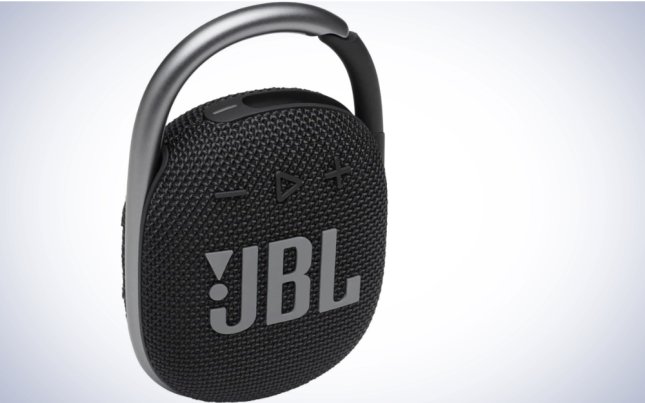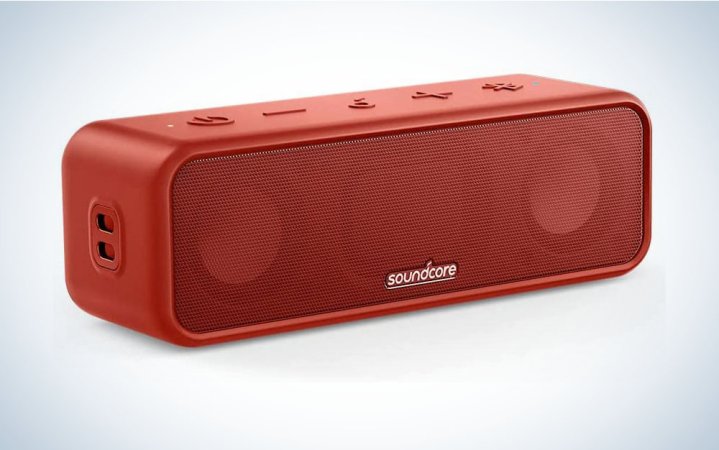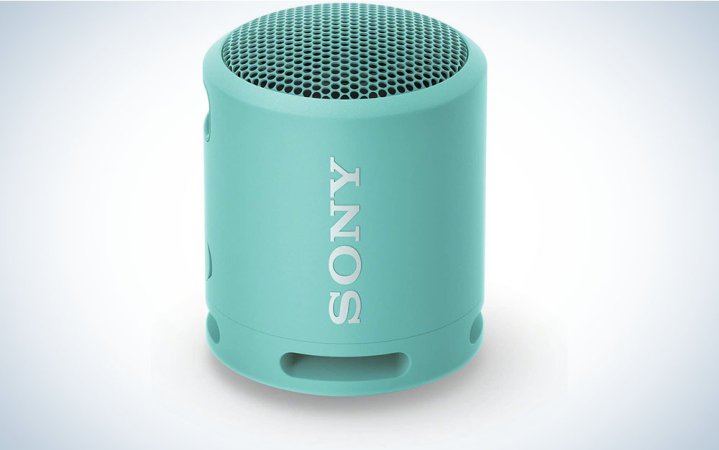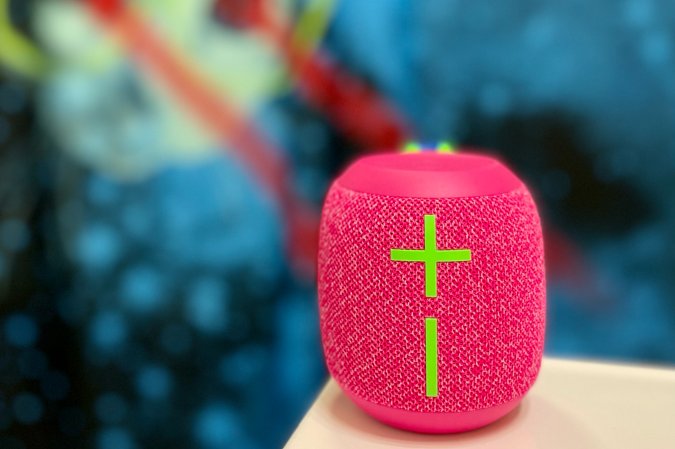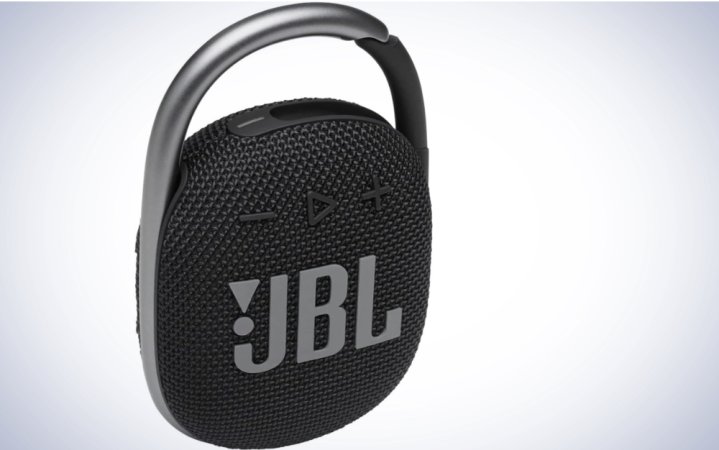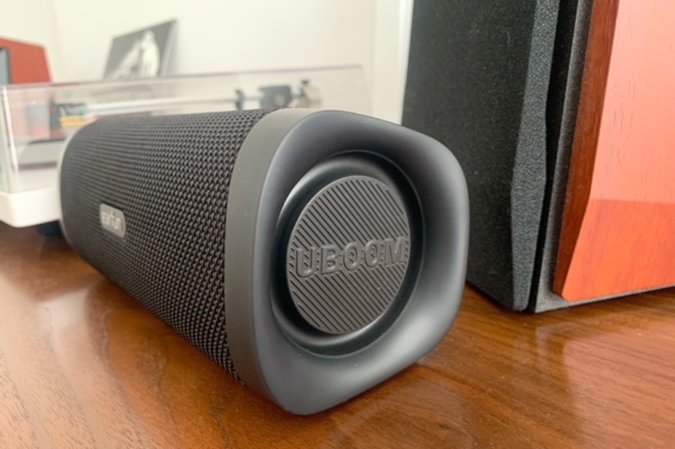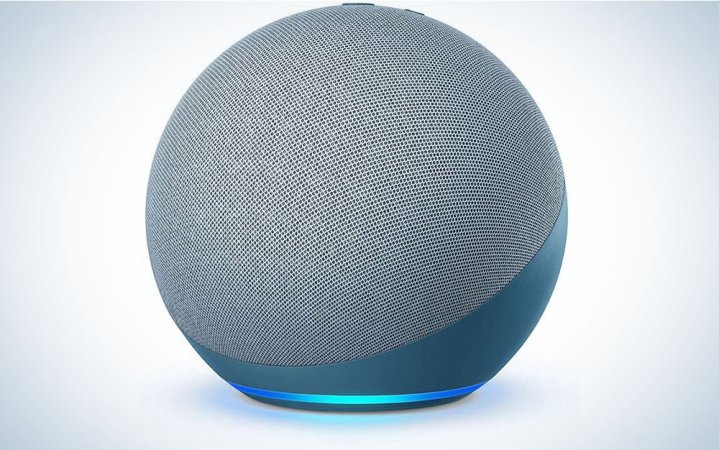We may earn revenue from the products available on this page and participate in affiliate programs. Learn more ›
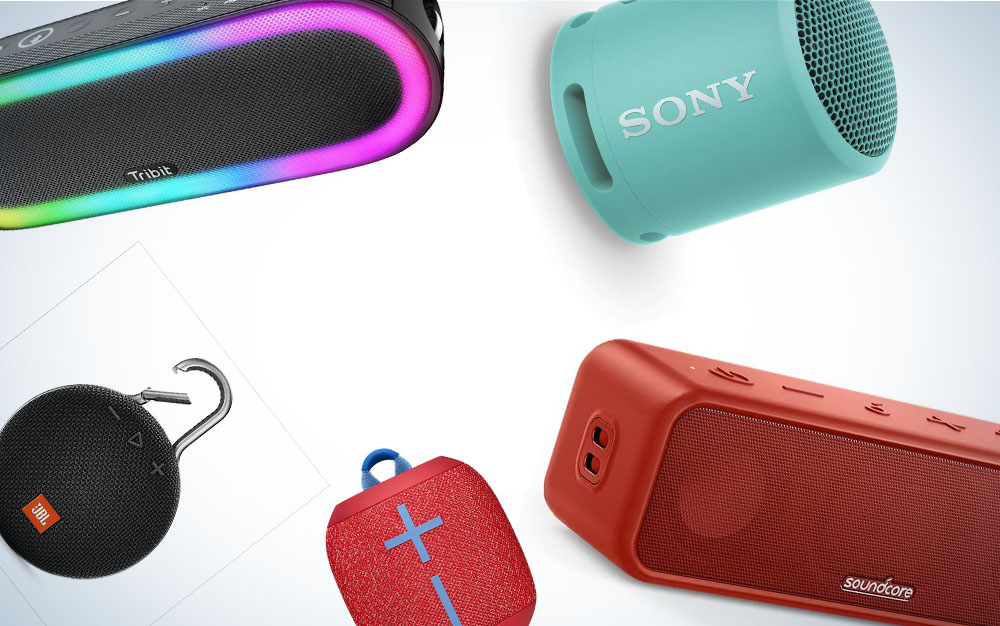
There is no shortage of Bluetooth speakers under $100, even $50, which can make choosing the right one for your listening needs particularly difficult. While you’d think a less expensive option might not boast outstanding audio quality or unbeatable battery life, there are many models—like our best overall pick, the Anker Soundcore 3—that are going to deliver exactly what you need when it comes to wire-free listening. Hone in on your top priorities and search accordingly. Do you need something waterproof? There’s one here. A speaker that will clip onto a backpack? We got you. Or maybe something extra bass to bump at a party? No problem. When it comes to the best budget Bluetooth speakers, it’s okay to focus on one or two central features so you get the most bang for your buck. Here are picks for speakers that can fit your needs and your budget.
- Best overall: Anker Soundcore 3
- Best for bass: Sony SRS-XB100
- Best waterproof: Ultimate Ears WONDERBOOM 3
- Best for travel: JBL Clip 4
- Best budget: Oontz Angle 3
- Best party speaker: Tribit XSound Mega
- Best for (viewing) parties: EarFun UBOOM L
- Best smart speaker: Amazon Echo (4th Gen.)
How we chose the best budget Bluetooth speakers
Many of the speakers recommended here have been personally tested by myself or our team, which is why we confidently recommend this selection. We retested some of our personal favorites and compared them to new units from other reputable brands with a focus on sound quality. While smaller portable speakers can’t deliver audio that’s as precise as premium stereo or multi-channel models, we made sure to pick products that preserve the integrity of our favorite albums. To further pare down the list, we only looked at speakers that currently retail for under $115, primarily focusing on those around $50, while paying particular attention to durability, portability, and battery life. Then, we considered special features like onboard controls, EQ customization, and connectivity to bring you the best of the best when it comes to affordable Bluetooth speakers.
The best budget Bluetooth speakers: Reviews & Recommendations
If you visit my apartment, you will immediately see a veritable wall of Bluetooth speakers, large and small. I have what some may call a deep enthusiasm for portable sound that doesn’t require equally deep pockets or corners. And I’ve found that the best cheap Bluetooth speakers don’t have to sound dinky. In fact, many options provide solid sound for less. While shopping, consider your top priorities for your budget-friendly speaker. Do you emphasize battery life, portability, water resistance, or sound quality? Once you can answer this question, you can pick out an excellent speaker from our picks without spending a fortune.
Best overall: Anker Soundcore 3
Pros
- Excellent Battery Life
- Sound Quality
- Bass Up technology
- Customizable EQ
Cons
- Simplistic design
- Voice assistant capability is lacking
Why it made the cut: The Soundcore 3 is a well-rounded, budget-friendly Bluetooth speaker with an impressive 24 hours of battery life and the option to boost the bass without distortion.
Specs
- Battery Life: 24 hours
- Bluetooth Range: Up to 66 feet
- IP Rating: IPX7
- Size: 6.9 x 2.4 x 2.2 inches
The Soundcore 3 is a robust, portable Bluetooth speaker that won’t cost an arm and a leg, making it the best budget Bluetooth speaker overall. Available in four colors, this powerful unit utilizes 16 watts of power to push dual 1.5-inch drivers with titanium diaphragms. Meanwhile, dual passive radiators combine with improved BassUp technology to analyze music in real-time and work to punch up the low-end during your favorite bass-driven songs. Alongside BassUp, there are three additional preset EQs you can choose from, or customize your own using the Soundcore app. The treble on the Soundcore 3 stretches all the way up to 40kHz. Bluetooth 5.0 offers a consistently stable connection and PartyCast compatibility means you can link up to 100 Soundcore speakers for a truly impressive array of sound. To get a full battery faster, this speaker charges via USB-C, and the 24-hour battery life beats more expensive models. While $55 isn’t the steepest cost if you needed a replacement, an IPX7 rating means you won’t have to worry about water damage if you get caught in the rain or drop it in the pool. And if you’re definitely planning to fill a patio with friends, there’s also the Anker Soundcore Glow Mini, an outdoor-friendly speaker that offers 360-degree sound, a pulsing LED halo, and IPX7—all for less than $50.
Best for bass: Sony SRS-XB100
Pros
- Removable strap
- UV coating
- Five cool colorways
- Extra Bass
Cons
- Extra bass isn’t adjustable
Why it made the cut: The SRS-XB100 is a compact, portable waterproof speaker that automatically boosts the bass for party-worthy sound wherever you are.
Specs
- Battery Life: 16 hours
- Bluetooth Range: Up to 32 feet
- IP Rating: IP67
- Size: 3.43 x 3.43 x 4.41 inches
If you’re looking for a compact speaker that weighs less than 1 pound and costs less than $50 but doesn’t sacrifice bass-booming sound, then the SRS-XB100 is the best bass Bluetooth speaker for you. With a 20Hz – 20kHz frequency response and a dedicated passive radiator to reinforce low-end, your music won’t be found lacking when it comes to heart-thumping beats. An IP67 rating means it’s protected from water and debris, so you can toss it into your beach bag without worrying about sand getting into the speaker grill. Available in five modern colors, each unit comes with a matching multiway strap, so you can easily carry the speaker if you run out of room in your backpack, or hang it up for easy access at a pool party. With an extra XB100 speaker, you can enable stereo mode, and a USB-C port means you can charge quickly to keep the party going all night long. And the integrated microphone means you can have a conference call from the campfire.
Best waterproof: Ultimate Ears WONDERBOOM 3
Pros
- Easily portable
- Can be submerged for up to 30 minutes
- Impressive volume
Cons
- No microphone
- No USB-C charging
Specs
- Battery life: 14 hours
- Bluetooth range: 131 feet
- IP rating: IP67
- Size: 3.68 x 3.68 x 4.02 inches
The WONDERBOOM 3 from Ultimate Ears is a great option for any listener who needs the perfect shower speaker or pool-party pal. The unique design is an immediate eye-catcher, and the sound quality is genuinely impressive for its size. Power by two active drivers and two passive radiators, coverage is pretty great with solid reproduction across the lows, mids, and highs. Granted, it doesn’t have the heart-pounding bass a larger speaker would, but will certainly do for poolside, lakefront, or river raft listening. Plus, it can be paired with a second WONDERBOOM for even better stereo sound. An Outdoor Boost button at the bottom of the speaker adjusts the sound to suit your environment better.
If you’ve ever seen a picture before of the WONDERBOOM 3, chances are it’s bobbing around in a pool or being sprayed with water from a rogue splash. This is, yes, because of target ads, but also because this tiny but mighty speaker is genuinely well-suited for “aquatic” listening. The IP67 rating means it’s essentially waterproof. Specifically, you can submerge this model in up to 1 meter of water for up to 30 minutes. It’s okay to accidentally drop this speaker in the pool, bathtub, or ocean. This rating also means it’s also protected from dust and debris.
Build-wise, you get a stable rubber loop at the top of the speaker that can easily clip to a backpack or make for easier carrying. You’ll also get large, easy-to-use onboard controls, so you won’t have to get your pruney wet fingers all over your smartphone just to change the volume or skip a song. The WONDERBOOM 3 comes in four fun colors, including “Hot Pink” and “Performance Blue.”
In 2024, UE released a WONDERBOOM 4, which does make some small but welcome tweaks to the speaker (USB-C charging, for instance) while keeping the same form factor. The WONDERBOOM 4 is now the $99 model, so still qualifies for this guide, but the WONDERBOOM 3 is still a fantastic speaker now priced closer to $60, so it remains our pick if you don’t mind keeping a microUSB cable around. And, if you dig the aesthetic and budget becomes less of a concern, the new, admittedly more expensive EVERBOOM and EPICBOOM bring a lot more bass and even more battery to the party, while remaining floatable.
Best for travel: JBL Clip 4
Pros
- Excellent design
- USB-C charging
- Good volume
Cons
- No fast charge
- No wired connectivity
Specs
- Battery life: 10 hours
- Bluetooth range: 32 feet
- IP rating: IP67
The JBL Clip 4 is a small speaker designed to keep you connected wherever your travels take you. Weighing just over half a pound, with an integrated carabiner clip, you can attach this speaker to your backpack, suitcase, bike handle, lunch box, belt loop, etc. There are rubberized grips on the speaker’s backside to increase stability, and the textured wrap covering most of the speaker is easy to hold onto. All in all, this is the easiest speaker to grab and go if you’re hiking or cycling; plus, it has an IP67 rating, so you can even attach it to your shower rod, beach tent, or foldable kayak (yes, it’s a thing).
Sound quality is pretty solid for such a small unit thanks to an impressive dynamic driver; plus, it can get loud for a 5-watt output (JBL knows how to build a potent party speaker and sensational shower speaker). Yes, it’s a little lacking in low-end, but that’s par for the course. Overall, this little guy sounds great. Sound can be controlled by five onboard buttons and charges via USB-C.
If you don’t want to play the $80 market price for the Clip 4, check out early models, like the Clip 3, which are still available for just under $50.
Best budget: Oontz Angle 3
Pros
- Extended Connectivity Range
- Price
- Stereo Drivers
Cons
- Not fully environment-proof
- Limited onboard controls
- Sound quality is just okay
Why it made the cut: With an impressive connectivity range, solid battery life, and thousands of positive user reviews, the Oontz Angle 3 is one of the best budget Bluetooth speakers for those looking to spend less than $35.
Specs
- Battery Life: 14 hours
- Bluetooth Range: Approx. 100 feet
- IP Rating: IPX5
- Size: 5.3 x 2.8 x 2.6 inches
While the Angle 3 isn’t touting many bells and whistles, it will have what you need to take tunes with you on the go. It’s got 10 watts that power acoustic stereo drivers, as well as a passive radiator—all wrapped up in 10 different colorways. Equipped with Bluetooth 5.0, this wedge-like speaker delivers a strong connection across 100 feet and is compatible with most current devices. With its IPX5 rating, you won’t want to toss this model into the pool, but you don’t need to worry about a few splashes or drops of rain. While the volume is certainly there, don’t expect a lot when it comes to wide stereo, booming bass, or true clarity across mids and highs. It’ll do the trick for lite listening on the go, but it won’t necessarily stand up to other, more expensive models. That being said, if you just need something that’s far preferable to silence, the Angle 3 should do the trick.
Best party speaker: Tribit XSound Mega
Pros
- 3 listening modes
- Dual charging/powerbank ports
- Music-activated lighting
- Carrying strap
Cons
- Some distortion at high volumes
- Pricier
Why it made the cut: Boosted bass, additional EQ presents, and a veritable light show deliver a high-end listening experience at a reasonable price.
Specs
- Battery Life: 20 hours
- Bluetooth Range: Up to 98 feet
- IP Rating: IPX7
- Size: 10.66 x 3.42 x 3.14 inches
If you’re having a gathering with more people you’re going to want more sound, and that may mean spending a little more, so here’s the best Bluetooth party speaker if your budget can stretch slightly above $100. The Tribit XSound Mega, released in early January, follows the waterproof, outdoor-friendly, ultraportable XSound Go models with a similar form factor but significant upgrades when it comes to sound quality and visual appeal.
Right out of the box, the Mega feels sleeker than some of its contemporaries with a texturized rubber surface that’s easy to grip, a black speaker grill, a discrete brand label, and smooth, integrated onboard controls. These seven intuitive buttons control power, Bluetooth pairing, play/pause, volume down, volume up, light adjustment, and EQ adjustment. Directly underneath the EQ Mode button are three indicators that will tell you which mode has been triggered: options include XBass, Music, and Audiobooks. At the back of the speaker is a rubber panel housing USB-A and USB-C ports for charging/using the 8000mAh battery as a powerbank to top off other devices, plus an AUX input. The included carrying strap is black and grey with silver hardware and two small carabiners easily clip onto the discrete embedded handles, which certainly helps shoulder the speaker’s 2.2 pounds. The visual pièce de résistance is the frame of LEDs that surrounds the front face of the speaker—a rainbow gradient of light that slowly cycles through colors while you pair your device.
Bluetooth 5.0 pairing is simple and easy, following the standard protocol of most speakers. The Mega is also equipped with NFC (Near-Field Communication), this is the same technology that allows you to tap your phone at a point-of-purchase to use ApplePay or Android Pay. NFC eliminates the need to push buttons and scroll through settings by allowing you to simply tap your speaker and phone together to establish a secure connection. Unfortunately, Apple hasn’t equipped any of their phones with controllable NFC modes, so you can only take advantage of this function if you have an Android or another device running Windows 10 or higher. The final pairing option you can consider is Broadcast Mode, which will allow you to link more than 100 XSound Megas together for a boost in volume or stereo playback.
When it comes to sound quality, this Tribit speaker has the thump if not exactly the clarity and soundstage of comparable models, like the JBL Charge 5. An impressive 30 watts power a driver with a pure titanium diaphragm, which combines with two passive radiators to reproduce low frequencies to 45Hz and high frequencies up to 14kHz. Audiobook mode successfully isolates the dulcet tones of Jim Dale, who you might recognize as the reader of the Harry Potter series, though the audio can get a little muddy if you are listening to a music- or sound design-heavy podcast. However, Isobel Campbell and Mark Lanegan’s sultry vocals and staccato keys on “Come Undone” are smooth and clear when Music mode is triggered. The low-end on Subtrakt’s “Wildfire” is big and bold when XBass is engaged, delivering a party-appropriate level of “thump” to get things going without overpowering the vocals. The volume can reach over 100 dB but some distortion does occur when pushed to its max, though that is to be expected from a speaker of this size.
One of our favorite features is the light display, which flashes in time with the beat of whatever you are playing. You can select from different options: a continuous oval of rainbow lacing glowing around the speaker grill’s perimeter; colors pulsing rhythmically in a symmetrical left/right or top/bottom pair, almost mimicking the metering you’d see on a recording studio console or DAW; or a circuit traveling the display track changing color, speeding up and slowing down in time with the beat. You can also forgo the light display altogether, but a 20-hour battery life keeps all that flair from fading fast.
While this model is a bit more expensive than other budget-friendly models, you will certainly get what you pay for when it comes to audio quality and special features.
Best for (viewing) parties: EarFun UBOOM L
Pros
- Video mode
- Aux connection available
- Stereo Pairing
Cons
- Short charging cable
- Only available in black
Why it made the cut: Its wide, rich sound, surprising for a speaker this size, delivers a powerful listening experience at a reasonable price.
Specs
- Battery Life: 16 hours
- Bluetooth Range: up to 50 feet
- IP Rating: IP67
- Size: 8.27 x 3.07 x 2.83 inches
The UBOOM L from EarFun is a budget-friendly Bluetooth speaker that delivers surprisingly impressive sound. While the texturized black grill, rubber trim, and raised buttons resemble its predecessors and contemporaries (like the Treblab HD77 or JBL Flip 5), its price:performance helps this compact speaker stand out in the sub-$100 crowd. Two 14-watt, 55mm drivers and dual passive radiators support potent but balanced playback across the full frequency range. Bluetooth 5.0 supports a stable connection for up to 100 feet of distance. Multiple devices can connect to the UBOOM L, so you can easily pass along the party playlist responsibilities; to really kick things up a notch, you can easily create a stereo pair using two UBOOM Ls, widening coverage and essentially doubling volume (great for gatherings). Three listening modes are available: Indoor, Outdoor, and Video—the most unique of the bunch. Using digital signal processing (DSP) technology, Indoor mode focuses on sonic clarity and depth, while Outdoor mode boosts volume and low-end bump. Video mode supports low-latency playback with lag reduced to 150ms, making it an excellent solution to greatly improve sound when watching movies and TV shows from a laptop or other device with smaller internal speakers. A built-in microphone makes hands-free calls an option, and an IP67 rating means the appropriately portable speaker is protected from dirt and water damage when you take it to the pool or on a trek.
Best smart speaker: Amazon Echo (4th Gen.)
Pros
- Sound quality
- Auxiliary port
- Built-in mic
Cons
- Not portable
- Not waterproof
Why it made the cut: For under $100, the 4th-gen. Amazon Echo is the perfect at-home speaker with a built-in microphone, impressive sound quality, and multiple connectivity options.
Specs
- Battery Life: Not rechargeable
- Bluetooth Range: 30 feet
- IP Rating: None
- Size: 5.7 x 5.7 x 5.2 inches
While the Amazon Echo is not a speaker you can take with you on the go, it is the best option for indoor listening if you’re assembling a smart-home system around Alexa. Like its Echo predecessors, the 4th-generation model is easy to use and compatible with many smart devices, doubling as a smart home hub for those who have smart lights, switches, doorbells, locks, and more. Even without the extra fixtures, Amazon’s voice assistant Alexa can help you set up timers, reminders, check the weather, call your family and friends, or call up your favorite playlists. The built-in microphone and speaker capabilities make for streamlined, hands-free communication. Installing more than one Echo in your home means you can program and sync multiroom music.
Available in three sleek colorways, the Echo will not only look good but sound good, with dual front-firing 0.8-inch tweeters and surprising bass thanks to a 3.0-inch neodymium woofer. These three drivers combine to deliver a satisfying thump and improved clarity, plus they support Dolby Audio (but not Dolby Atmos). Wi-Fi enabled, you can cast music from your phone if you’re on the same network or let it take direct advantage of connected services like Amazon Music HD, Audible, or Spotify Connect if you want to reserve your Bluetooth for another device.
The Echo orb is equipped with onboard controls that will allow you to control volume, mute the microphone, or skip tracks. An LED ring at the base of the speakers will illuminate when Alexa has been activated and glow red when the microphone is muted. At the back of the speaker, you’ll find a power input port and an aux port for analog connections. The Echo is not a portable speaker, so it will need to stay plugged in at all times, though the Bluetooth 5.0 connection means you can play from just about any smart device in your home (and most rooms, depending on the layout of your walls).
Here are other options we think sound like a good investment:
- Best battery life: Tribit XSound Go
- Best ultraportable: JBL GO 3
- Best compact connected speaker: Echo Dot (5th Gen)
- Best to strap on a bike: Tribit StormBox Micro 2
- Best with RGB lights: TREBLAB HD-Mini
Things to consider before buying the best budget Bluetooth speakers
In order to find the best budget Bluetooth speaker for you, think about what features will be a defining factor in your final decision. Are you prioritizing battery life? Volume? Portability? When it comes to inexpensive speakers, you might not have all the fancy features of a high-end model at your fingertips, but as long as you know what you want to focus on, you’ll be satisfied.
What should a budget Bluetooth speaker sound like?
Sound quality is typically a top priority, no matter what kind of speaker you’re looking at. While we cannot expect a 6-inch speaker to carry the same sonic weight as a set of premium monitors, you can still make smart choices if you value sound above the rest.
First and foremost, if you want better sound you’ll have to sacrifice a little bit of portability. That’s because larger units are generally more equipped to maintain consistent, distortion-free audio even as you turn the volume up (a common critique of compact speakers is that though they can get pretty loud, the audio quality significantly degrades with each decibel). Bigger speakers also have more room for well-designed subwoofers, which provide an accurate low end that won’t totally overpower the mids and highs, making for a more satisfying mix.
If you really want booming bass but can’t upgrade when it comes to size, many smaller units now come equipped with “bass boosting” technology that uses digital signal processing to put an emphasis on low-end frequencies that bumps without any rattle. While this can be a major pro for parties or at-home workout playlists, beware of speakers that use these boosts to overcompensate for a lack of clarity throughout other frequencies.
To learn more about where your new speaker will succeed or fall short when it comes to audio quality, look at the frequency response. Measured in hertz and kilohertz, this range lets you know the range of frequencies (lows, mids, and highs) the speaker will support. More often than not, you’ll see a response range from 20Hz – 20kHz, which are the limits of human hearing for both highs and lows. This is certainly an ideal range; however, just because the model boasts a wide range doesn’t mean it won’t suffer from dips and peaks around specific frequencies. For a really in-depth understanding of the speaker’s success at accurately reproducing audio, you can take a look at a frequency response graph for the product, often created with audio testing by a third party.
For more information about volume, check out the speaker’s specs to find a maximum decibel level, notated as dB. If you are primarily playing music inside, you won’t need to go over 100 dB and we don’t even recommend listening at that level, as it’s akin to listening to a jackhammer at close range. On the other hand, if you’re hosting an outdoor party with many people in attendance, you could think about increasing the volume to 115 dB, which is concert-level; music at this volume will cover a large area, but you wouldn’t want anyone standing too close. Generally speaking, we are satisfied with Bluetooth speakers that maintain good sound quality at 85 dB for larger gatherings. As I write, I am happily listening to music at 74 dB and really don’t require any more volume.
What’s the deal with codecs and connectivity?
While options can be limited when it comes to budget speakers, we recommend looking for gear that supports the most recent version of Bluetooth you can find (at the moment that’s anything in the 5.0 range). A Bluetooth 5.1 or 5.2 and especially 5.3 or 5.4 speaker will have a more stable connection, which makes it easier to support brand-specific features like allowing more than one person to connect and control the speaker at a time. Bluetooth 4.0 will still function just fine with most devices, but you may miss out on some range, stability, and special features like multiuser pairing.
A Bluetooth codec describes the way in which your digital audio data is encoded and decoded from a source device to your speaker or headphones. To get the most from these high-speed transfers both your receiver and transmitter need to be equipped with the same codecs. The most common codec to see is SBC, which is supported by every Bluetooth speaker. While not the highest quality codec, it’s a virtually universal, reliable way to transfer data. If you’re an iOS user looking for higher quality, consider a speaker with AAC, or Advanced Audio Coding. If you have an Android smartdevice, select a speaker with aptX/aptX HD/aptX Adaptive (or LDAC) support for faster transfer rates that preserve more data.
One final thing to keep in mind when considering connectivity is Bluetooth range. This describes how far you can wander away from your device before the sound starts to get fuzzy and eventually you get disconnected. If you plan to never leave your speaker’s side, you’ll probably be fine with a connectivity range under 30 feet. However, if you’re listening to music outdoors, need to go inside, and you don’t want to leave your phone unattended, then look for a speaker with a range above 35 feet.
What kind of special features should you look for?
Typically, the best budget Bluetooth speakers lack high-flying special features, though this isn’t always the case. If a Bluetooth speaker provides custom EQ options via an app or onboard control, that is a major win. Custom equalization will give you way more control over your sound and is particularly helpful if you are listening to various types of media—as you certainly won’t need to boost the bass when you’re listening to Terry Gross on “Fresh Air.” Some inexpensive models are starting to roll out visual features first employed by higher-end models, like bold colorways or LED panels that pulse to the beat.
Another prime feature to look for is the elusive onboard microphone that will let you conduct phone calls or speak to voice assistants like Siri or Alexa without having to pick up your device.
What is the bare minimum when it comes to battery life?
Luckily, one of the things budget Bluetooth speakers rarely sacrifice is battery life. Even at a lower price, it’s unlikely you’ll come across a model that has less than a 10-hour charge and many can do even better. For infrequent listening at moderate volume, 10 hours of playback could last you up to a week; however, the louder you play your music, the faster battery life will be depleted. If a speaker boasts 13 hours of consistent playback, you may get something closer to 7-10 hours if you’re blasting EDM all night long. Party throwers and party-goers should look for a model that boasts a battery that can last over 12 hours.
How do you know if your budget Bluetooth speaker is actually waterproof?
The only way to guarantee your speaker is waterproof (or dustproof) is to look at its IP rating. If you’ve ever purchased a portable speaker before or checked out one of our other reviews, you’ll know that IP rating is one of the most important specs to check out before buying. This is especially true if you know you want to prioritize outdoor use. If you want a speaker to safely take you to the beach or into the shower—make sure you investigate how well it’s already protected from the elements.
IP stands for “Ingress Protection,” which tells you just how fortified an electronic device is against dirt, dust, and water. These ratings are typically composed of two numbers, or one number and an X. We often cite the Wonderboom 2, a tried-and-true favorite, when it comes to durability. The Wonderboom 2 has an IP67 rating. The first digit describes particle protection, the second liquid. The “6” indicates it can keep out most dust and dirt particles, while the “7” means it can be submerged in up to 1 meter of water for 30 minutes before any damage occurs, making it a great option for poolside tunes. The higher the number, the more protected your speakers will be from debris and water. This is why you can often find the Wonderboom poolside, or hanging off a showerhead.
You may find an IP that replaces particle protection with an “X,” written as IPX7, for example. An “X” in place of any number means no data is available for that substance, or rather that the unit is not protected from that substance.
FAQs
Yes, cheap speakers can sound good. Of course, the more you can invest, the more options you’ll have when it comes to special features, more powerful drivers, better frequency response, etc., but you don’t necessarily have to spend thousands to get good sound quality. Generally speaking, smaller speakers can’t carry the sonic load a larger speaker can (hence why portable Bluetooth speakers often lack low-end), but this doesn’t mean you can’t find something inexpensive that will suit your listening tastes. Of course, if you’re an audiophile a cheap Bluetooth speaker isn’t going to live up to your standards.
The best Bluetooth speaker brand is widely debated and will certainly depend on your unique needs and preferences. Bang u0026 Olufsen are known for turning out high-end products with excellent sound quality. Sonos continues to top the charts when it comes to in-home connectivity. For more rugged, portable models our favorite brands have to be Ultimate Ears and JBL, both of which have products that claimed top spots in this article.
When it comes to finding the best budget Bluetooth speakers, JBL is going to give you more variety. They have a diverse range of budget-friendly options in various sizes, with distinctive features, including the JBL Clip 4 and JBL Go 3. These JBL models are compact, travel-friendly units designed to move with you. Currently, Sony only has one Bluetooth speaker under $90, the Sony SRS-XB100—a model we love, but you might be better off searching elsewhere for inexpensive speakers. Return to Sony if your budget gets a bit higher, or if you start the search for other techy treats, like a new television or game console.
Similar to the JBL versus Sony debate above, JBL continues to come out on top when it comes to affordable options. Bose does not currently have a model, the SoundLink Micro, that regularly retails for under $119. However, if you plan on looking for a high-end speaker, soundbar, or home system in the future, Bose is certainly a brand worth investigating.
There are a few things you can do to improve the battery life of your Bluetooth speaker. While you can’t magically make it extend its absolute maximum playtime, you can try to prevent an early battery death. The first thing to do is to lower the volume. If you are listening at max volume all day, your speaker is going to die significantly faster. Second, when you’re not using the speaker, ensure it’s off. Some units power down automatically after a certain period of time when nothing is playing; others need to be manually shut off.
Final thoughts on the best budget Bluetooth speakers
- Best overall: Anker Soundcore 3
- Best for bass: Sony SRS-XB100
- Best waterproof: Ultimate Ears WONDERBOOM 3
- Best for travel: JBL Clip 4
- Best budget: Oontz Angle 3
- Best party speaker: Tribit XSound Mega
- Best for (viewing) parties: EarFun UBOOM L
- Best smart speaker: Amazon Echo (4th Gen.)
You don’t need to go above and beyond your means to find the best value Bluetooth speakers that will satisfy your sonic needs. There are plenty of options out there that you can take with you to the park, beach, or nearest house party without breaking the bank. Generally speaking, an inexpensive speaker won’t have all the bells and whistles a fancier model might, but you can still tune into your favorite audiobooks, podcasts, and playlists—which, at the end of the day, is all the best cheap Bluetooth speaker is designed to do.


